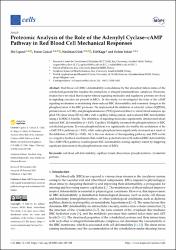| dc.contributor.author | Uğurel, Elif | |
| dc.contributor.author | Göksel, Evrim | |
| dc.contributor.author | Çilek, Neslihan | |
| dc.contributor.author | Kağa, Elif | |
| dc.contributor.author | Yalçın, Özlem | |
| dc.date.accessioned | 2022-05-17T06:48:07Z | |
| dc.date.available | 2022-05-17T06:48:07Z | |
| dc.date.issued | 06.04.2022 | en_US |
| dc.identifier.citation | Ugurel, E., Goksel, E., Cilek, N., Kaga, E., & Yalcin, O. (2022). Proteomic Analysis of the Role of the Adenylyl Cyclase–cAMP Pathway in Red Blood Cell Mechanical Responses. Cells, 11(7), 1250. | en_US |
| dc.identifier.issn | 2073-4409 | |
| dc.identifier.uri | https://doi.org/10.3390/cells11071250 | |
| dc.identifier.uri | https://hdl.handle.net/20.500.12933/1023 | |
| dc.description.abstract | Red blood cell (RBC) deformability is modulated by the phosphorylation status of the cytoskeletal proteins that regulate the interactions of integral transmembrane complexes. Proteomic studies have revealed that receptor-related signaling molecules and regulatory proteins involved in signaling cascades are present in RBCs. In this study, we investigated the roles of the cAMP signaling mechanism in modulating shear-induced RBC deformability and examined changes in the phosphorylation of the RBC proteome. We implemented the inhibitors of adenylyl cyclase (SQ22536), protein kinase A (H89), and phosphodiesterase (PDE) (pentoxifylline) to whole blood samples, applied 5 Pa shear stress (SS) for 300 s with a capillary tubing system, and evaluated RBC deformability using a LORRCA MaxSis. The inhibition of signaling molecules significantly deteriorated shear-induced RBC deformability (p < 0.05). Capillary SS slightly increased the phosphorylation of RBC cytoskeletal proteins. Tyrosine phosphorylation was significantly elevated by the modulation of the cAMP/PKA pathway (p < 0.05), while serine phosphorylation significantly decreased as a result of the inhibition of PDE (p < 0.05). AC is the core element of this signaling pathway, and PDE works as a negative feedback mechanism that could have potential roles in SS-induced RBC deformability. The cAMP/PKA pathway could regulate RBC deformability during capillary transit by triggering significant alterations in the phosphorylation state of RBCs. | en_US |
| dc.language.iso | eng | en_US |
| dc.publisher | MDPI | en_US |
| dc.relation.isversionof | 10.3390/cells11071250 | en_US |
| dc.rights | info:eu-repo/semantics/openAccess | en_US |
| dc.subject | Capillary transit | en_US |
| dc.subject | Cytoskeletal proteins | en_US |
| dc.subject | Phosphorylation | en_US |
| dc.subject | Red blood cell deformability | en_US |
| dc.subject | Shear stress | en_US |
| dc.title | Proteomic Analysis of the Role of the Adenylyl Cyclase–cAMP Pathway in Red Blood Cell Mechanical Responses | en_US |
| dc.type | article | en_US |
| dc.authorid | 0000-0002-2279-6105 | en_US |
| dc.department | AFSÜ | en_US |
| dc.contributor.institutionauthor | Kağa, Elif | |
| dc.identifier.volume | 11 | en_US |
| dc.identifier.issue | 7 | en_US |
| dc.identifier.startpage | 1 | en_US |
| dc.identifier.endpage | 19 | en_US |
| dc.relation.journal | Cells | en_US |
| dc.relation.publicationcategory | Makale - Uluslararası Hakemli Dergi - Kurum Öğretim Elemanı | en_US |
















